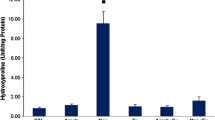Summary
The effect of different training regimes (three programmes of both swimming and running exercise) on the heart hypertrophy index and some biochemical indices was evaluated and compared individually with the sensitivity of the corresponding heart to ischaemia in order to elucidate the significance of training intensity and observed changes in the development of heart ischaemic injury. The sensitivity of the heart to ischaemia, evaluated by the rate of development of ischaemic contracture 48 h after completing the exercise programme, increased in parallel with an increase in the heart hypertrophy index. Experiments with different swimming programmes showed that the extent of cardiac hypertrophy increased together with an increase in the duration of everyday swimming bouts. Hypertrophied hearts from trained rats were characterized by greater mobilization of glycogen and increased incorporation of 32P into ATP when investigated 10 min after isoprenaline administration. During total ischaemia the development of ischaemic contracture was accelerated in catecholamine-stimulated trained hearts due to more rapid hydrolysis of ATP compared with that in the hearts from sedentary animals. It is suggested that the observed difference between hearts from sedentary and trained animals is, at least partially, connected with the higher sensitivity of myofibrils to Ca2+ in trained hearts.
Similar content being viewed by others
References
Bajusz E (1964) An ionic shift through which nonspecific stimuli can increase resistance of the heart muscle. Cardiologia 45:288–289
Baker PF (1986) Introduction. In: Evered D, Whelan J (eds) Calcium and the cell. Ciba Foundation Symposium 122. Wiley, Chichester pp 1–4
Baldwin KM, Cooke DA, Cheadle WG (1977) Time course adaptations in cardiac and skeletal muscle to different running programs. J Appl Physiol 42:267–272
Bassler TJ (1977) Marathon running and immunity to atherosclerosis. Ann NY Acad Sci 301:579–592
Berne RM, Rubio R (1974) Adenine nucleotide metabolism in the heart. Circ Res 34–35 [Suppl III]:109–120
Blackburn H, Jacobs DR (1988) Physical activity and the risk of coronary heart disease. New Engl J Med 319:1217–1219
Cantwell JD (1976) Marathon racing and myocardial infarction (letter). Ann Intern Med 85:391–392
Cohen MV, Yipintsoi T, Malhotra A, Penpargkul S, Scheuer J (1978) Effect of exercise on collateral development in dogs with normal coronary arteries. J Appl Physiol 45:797–805
Coplan NL, Gleim GW, Nicholas IA (1988) Exercise and sudden cardiac death. Am Heart J 115:207–212
Diffee GM, Tibbits GF (1985) Dihydropyridine binding to myocardial sarcolemma: adaptation to exercise. Clin Physiol 5 [Suppl 4]:29
Hearse DJ, Garlick PB, Humphrey SM (1977) Ischemic contracture of the myocardium: mechanisms and prevention. Am J Cardiol 39:986–993
Kôrge P (1974) Cation exchange in myocardium and its hormonal regulation during exhaustive physical exertions and training (in Russian). Thesis, Tartu University, Tartu
Kôrge P, Masso R, Roosson S (1974) The effect of physical conditioning on cardiac response to acute exertion. Can J Physiol Pharmacol 52:745–752
Lewartowski B, Pytkowski B, Pronapczuk A, Wasileska-Dzinbinska E (1982) Calcium exchange during single excitation of quinea pig ventricular muscle. J Mol Cell Cardiol 14:745–747
Lipasti JA, Nevalainen TJ, Alanen K, Tolvanen MA (1984) Anaerobic glycosis and the development of ischemic contracture in isolated rat heart. Cardiovasc Res 18:145–148
Los S, Russell J, Taylor A (1970) Determination of glycogen in small tissue samples. J Appl Physiol 28:234–236
Männik G, Vigel E, Viru M, Kôrge P (1988) The adaptation of myocardium to the physical load and its possible antiischemic mechanism (in Russian). Proc Acad Sci Est Biol 37:140–146
Maron BJ (1986) Structural features of the athletes heart as defined by echocardiography. J Am Coll Cardiol 7:190–203
Maron BJ, Roberts WC, McAllister HA, Rosing DR, Epstein SE (1980) Sudden death in young athletes. Circulation 62:218–229
McElroy CL, Gissen SA, Fishbein MC (1978) Exercise-induced reduction in myocardial infarct size after coronary artery occlusion in the rat. Circulation 57:958–962
McKenna WJ, Deanfield J, Faruqui A (1981) Prognosis in hypertrophic cardiomyopathy. Am J Cardiol 47:532–538
Meerson FZ, Ustinova EE, Chinkin AS (1987) Effect of preliminary adaptation to mild and heavy physical exercises on cardiac electrical stability and contractility in experimental myocardial infarction (in Russian). Kardiologiia (Moscow) 4:78–82
Morano I, Rüegg JC (1987) Calcium sensitivity of myofilaments in cardiac muscle — effect of myosin phosphorylation. Basic Res Cardiol 81 [Suppl 1]:17–23
Noakes T, Opie L, Beck W, McKechnie J, Benchimol A, Desser K (1977) Coronary heart disease in marathon runners. Ann NY Acad Sci 301:593–619
Noakes TD, Opie LH, Luble WF (1979) Catecholamine-dependent, enhanced myocardial performance in isolated perfused working heart from endurance training rats. Med Sci Sports 11:87
Resink TJ, Gevers W, Noakes TD, Opie LH (1981) Increased cardiac myosin ATPase activity as a biochemical adaptation to running training: enhanced response to catecholamines and a role for myosin phosphorylation. J Mol Cell Cardiol 13:679–694
Rost R (1988) Der plötzliche nicht-traumatische Tod im Sport. Fortschr Med 106:103–106
Salzman SH, Hellestein HK, Bruell HJ, Starr D (1968) Adaptation to muscular exercise: the effects on epinephrine induced myocardial necrosis in C3H mice. Circulation 38 [Suppl 6]:170
Scheuer J, Kapner L, Strungfellow CA, Armstrong CL, Penpargkul S (1970) Glycogen, lipid, and high energy phosphate stores in hearts from conditioned rats. J Lab Clin Med 75:924–929
Severson JA, Fell RD, Griffith DR (1978) Adrenocortical function in response to myocardial necrosis in exercise-trained rats. J Appl Physiol 44:104–108
Takeda N, Deminiak P, Türsk D, Rupp H, Jacov R (1985) The influence of endurance-training on mechanical catecholamine responsiveness, β-adrenoceptor density and myosin isoenzyme pattern of rat ventricular myocardium. Basic Res Cardiol 80:88–99
Tibbits G, Koziol BJ, Roberts NK, Baldwin KH, Barnard RJ (1978) Adaptation of the rat myocardium to endurance training. J Appl Physiol 44:85–89
USSR Health Ministry (1977) Guide for the care and use of Laboratory animals, no. 775, 12th August, 1977
Author information
Authors and Affiliations
Rights and permissions
About this article
Cite this article
Kôrge, P., Männik, G. The effect of regular physical exercise on sensitivity to ischaemia in the rat's heart. Eur J Appl Physiol 61, 42–47 (1990). https://doi.org/10.1007/BF00236692
Accepted:
Issue Date:
DOI: https://doi.org/10.1007/BF00236692




